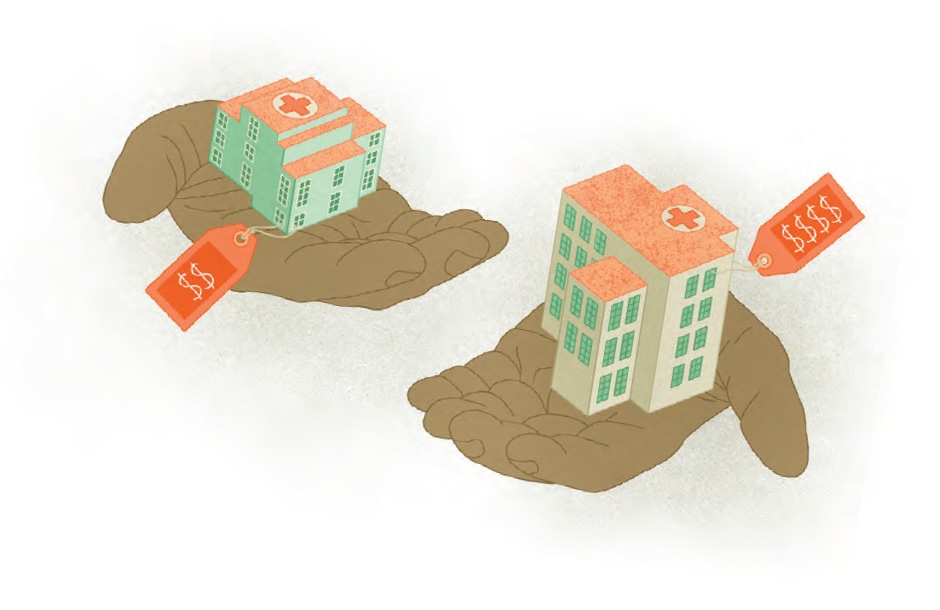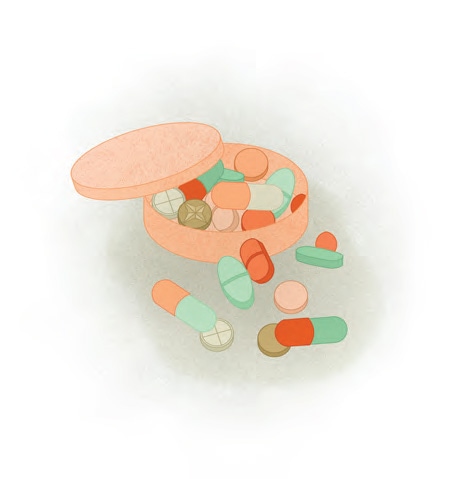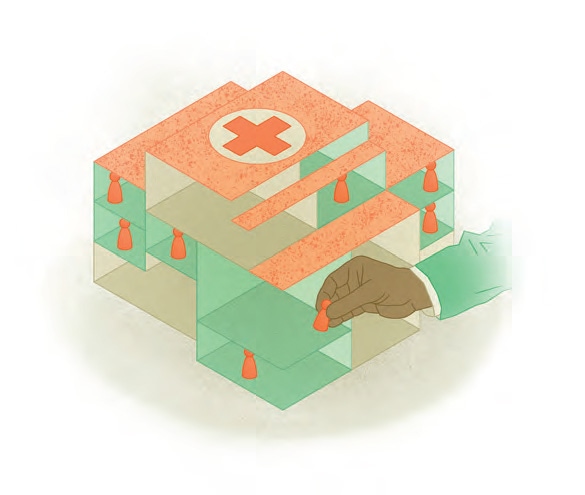Healthier Patients, Lower Costs

Healthier Patients, Lower Costs
Through their research, Kellogg faculty are answering critical questions about public policy, drug development, and how to make healthy decisions.
Will People Price Shop for Healthcare?
As consumers, we rarely know the exact price of a doctor’s visit or procedure until we receive a bill.
This is frustrating for individuals and is a problem for policymakers and insurers trying to motivate consumers to understand the cost–benefit trade-offs of their healthcare decisions.
“There’s a decades-long debate in healthcare about whether you can actually get people to shop on price,” says Elena Prager, an assistant professor of strategy at Kellogg. “We tend to view medical services as a different kind of product where price may not matter much.”
To research this, Prager used unusually transparent data on private health insurance claims from multiple insurers in Massachusetts from 2009 to 2012. Importantly, all these insurers gave consumers very clear information on out-of-pocket cost.
Additionally, in many of the health plans, these insurers group hospitals into “tiers” based on price. A hospital’s tier determines consumers’ out-of-pocket payment for a given procedure at that hospital.
In some health plans, the difference in cost from one tier to another was substantial; for others, there was little to no price differential; still others simply had the same copay for all hospitals without using tiers. This allowed Prager to compare how consumers responded to the option to price shop in a very transparent system.
She focused on inpatient services—such as major surgery—and found that even for these relatively involved procedures, people opted for lower-priced services when presented with clear, simple price information.
“People weren’t sure price shopping in healthcare was even possible,” she says. “These findings show that it is.”
Still, it takes an extremely simple approach to presenting out-of-pocket cost information to help people make healthcare decisions. “We haven’t been good at providing that in the U.S. system,” Prager says.
“ Private firms can simply deploy incentives and resources better to solve this complex problem.” — Amanda Starc
Can Privatizing Medicaid Drug Benefits Reduce Spending?
Rising drugs costs are another pain point for many consumers. And with Medicare and Medicaid making up a quarter of the federal budget and nearly 20 percent of state budgets, the public sector feels this pain as well.
So a group of Kellogg researchers—strategy professor David Dranove, associate professor of strategy Amanda Starc, and research assistant professor of strategy Christopher Ody—set out to understand whether private firms could use market mechanisms to control these costs.
In 2010, the ACA modified rules around how states collect rebates for prescription drugs that are purchased for Medicaid enrollees. This change encouraged more states to transfer oversight of Medicaid drug benefits to private firms. This in turn allowed the researchers to compare spending for states that both did and did not privatize oversight.
They found that, between 2010 and 2016, shifting the administration of drug benefits to private insurers reduced spending by 22.4 percent, with no decrease in quality of care. The savings were driven primarily by private insurers being able to negotiate drug prices with pharmacies more easily than states can, and by shifting patients from branded to generic drugs. The savings did not appear to come from reducing benefits related to drugs for serious conditions, or cutting the use of certain drug categories wholesale.
The findings highlight the potential of markets and private firms to reduce costs and boost efficiency in the critical, high-cost healthcare sector.
“We don’t expect the government to come up with right prices in any other segment of the economy,” Starc says. “So it’s crazy that we expect them to come up with them in healthcare. Private firms can simply deploy incentives and resources better to solve this complex problem.”
What Drives Drug Companies to Pursue Pharmaceutical Breakthroughs?
When choosing which new medications to develop, pharmaceutical companies must decide how much they want to innovate. Should they make an incremental improvement on an existing drug? Or should they create something entirely new?
Drugs have become less novel in the past couple decades, explains Dimitris Papanikolaou, a professor of finance at Kellogg. Given that new drugs have the potential to improve—or even save—lives, this trend could have severe consequences for society.
Papanikolaou and colleagues Joshua Krieger of Harvard Business School and Danielle Li of MIT Sloan School of Management sought to pinpoint what spurs companies to seek out a novel breakthrough versus incremental variations on existing medications, known as “me too” drugs.

They developed a method to quantify a medication’s level of novelty based on its chemical structure and applied it to a database of more than 64,000 drugs. More innovative therapies, they determined, had a lower chance of being approved by the U.S. Food and Drug Administration.
“If you’re trying something that hasn’t been tried before, you’re more likely to fail,” Papanikolaou says. “Firms may be averse to such experimentation, especially if financial market distortions make failure costly. Thus, financial frictions may be limiting innovation.”
This is somewhat surprising because innovative drugs appear to be better than derivative drugs on a variety of metrics. For example, novel drugs generated more revenue than me too drugs and they were also more likely to be categorized as “highly important” medications. Further, patents associated with novel drugs received more citations—a measure of their scientific value.
Yet the researchers found that firms were eager to work on novel drugs—under the right financial circumstances. When pharmaceutical companies got a profit windfall, they were more likely to spend these resources on developing novel drugs than on incremental improvements.
The results suggest that while novel drugs may be less likely to get through the approval process, they likely have more potential upside for the company and for patients.
“Few novel drugs end up being blockbusters, but many blockbusters are novel,” Papanikolaou says.
How Should the Orphan Drug Act Be Reformed?
Some pharmaceutical breakthroughs simply aren’t poised to generate oodles of revenue. That’s why Congress created the Orphan Drug Act in 1983.
The act incentivizes companies to invest in new drugs that can help the estimated 25 million Americans diagnosed with one of nearly 7,000 rare diseases. After all, if the population of patients who need a drug is small enough, companies are unlikely to recoup their investments, and needed therapies will never be developed.
At least that’s the concept behind the now 35-year-old act. But Craig Garthwaite, an associate professor at Kellogg, and colleagues Nicholas Bagley of the University of Michigan Law School and Amitabh Chandra and Ariel Stern of Harvard Business School, argue that it’s time to update the act so that it keeps pace with changes to the drug market.
In its current form, the act offers two types of incentives. First, tax credits help defray the cost of research and development. Firms can recoup 25 percent of the cost (until 2017, this number had been 50 percent). Second, companies developing an orphan drug get seven years of market exclusivity instead of the usual three to five.
The authors argue that this second incentive—extended exclusivity, which allows manufacturers to charge higher prices during that time—should be ended because a large number of orphan drugs face no competition even after their period of monopoly ends.
They support continuing to use tax credits as incentives, but propose two changes to how they are implemented.
First, there should be a “clawback” provision for drugs that end up earning enough in revenue that they could have been developed without any government incentives. Japan, for instance, already has such a provision.
Second, firms that get tax incentives should agree to some form of price regulation after the patent expires. “Drugs that have already enjoyed their patent protection have received the financial reward that society has deemed appropriate,” the authors write.
“It is long past time to reform the Orphan Drug Act for the 21st century,” the authors conclude, “and to evaluate current policies to assure that benefits are targeted at those orphan drugs that otherwise would not come to market.”
“ Better utilization of OR capacity helps the hospital see more patients in a shorter period of time.” — Chaithanya Bandi
Would Banning E-cigarette Ads on TV Backfire?
Another candidate for a 21st century overhaul: the ban on cigarette ads.
Indeed, it would feel jarring to see an ad for cigarettes on TV these days. After all, they’ve been banned since the 1970s. But ads for electronic cigarettes, or e-cigarettes, are not included in this ban.
Although e-cigarettes are generally considered to be less harmful than their conventional counterparts, critics argue their ads should also be banned. They cite a few main concerns: nonsmokers may start with the electronic products and move on to conventional cigarettes; viewers might subconsciously conflate the two products; or the ads could make smoking socially acceptable again.
Opponents of an advertising ban, on the other hand, say the commercials could be prompting smokers to switch to e-cigarettes and thus improve their health overall. So who has it right?
A study by Anna Tuchman, an assistant professor of marketing at Kellogg, provides one of the first attempts to understand the effects of e-cigarette ads.
Using data on nicotine product sales at about 35,000 stores in the U.S. from 2010 to 2015, as well as data on e-cigarette TV advertising across the country, she found that increasing e-cigarette ads by 10 percent was linked to a 0.2 percent drop in traditional cigarette sales. While this effect sounds small, she notes it is comparable to ad effects measured in other industries.
The same 10 percent increase in e-cigarette ads also led to a 0.8 percent increase in e-cigarette sales. But because the e-cigarette market is much smaller than the traditional cigarette market, overall nicotine consumption still decreased, Tuchman found.
Next, she analyzed data on the shopping patterns of nearly 900 households that had bought at least one e-cigarette product from 2010 to 2015. She found that if a household had recently purchased e-cigarettes, they were less likely to buy traditional cigarettes—suggesting that e-cigarettes did not encourage smoking.
Still, she cautions that these results do not uniformly show that allowing e-cigarette ads is a positive.
For instance, the data also suggested that increases in e-cigarette ads were linked to lower sales of nicotine patches and gum. If people are abandoning efforts to quit smoking because they figure they can vape instead, that would be a concern, Tuchman says. And the study does not address one of the biggest concerns about the ads: that regardless of the impact on overall sales, young people might be particularly vulnerable to developing an ultimately harmful habit.

Is There a Better Way to Schedule Surgeries?
For hospital administrators, scheduling surgeries in the OR is a complex—and costly—puzzle.
Operating rooms typically cost $1,000 per hour to run. But they also make money. Surgeries and associated hospitalizations generate roughly 70 percent of total hospital revenues. So optimizing OR scheduling is a top priority for administrators.
This presented a tantalizing research challenge for Chaithanya Bandi, associate professor of operations at Kellogg, and Diwakar Gupta of the McCombs School of Business at the University of Texas. They studied 18 months of surgical-request data at a large hospital and found that, in order to accommodate surgeon requests, the hospital generally kept more ORs at the ready than were needed.
“Surgeons are very important from a hospital’s point of view,” Bandi says, “so the administrators work hard to respect their preferences.”
Compounding this difficulty is the fact that OR requests arrive at unpredictable times since patients’ health problems do not occur on a regular schedule. And surgeries do not always take the anticipated amount of time.
So the researchers developed an innovative algorithm to improve OR operations.
A typical hospital, like the one in the study, keeps about 10 ORs open, Bandi says. The algorithm shows that keeping eight rooms open would be enough to handle patient needs.
The researchers knew, however, that this first analysis did not take into account more specific surgeon requests, such as wanting the same surgery times each week. The second phase of the research thus accommodated specific requests by either shuffling surgeries among available ORs, adding another OR, or a combination of both.
Even with this added flexibility, using the algorithm had the potential to generate a large savings—anywhere from 10% to 25% in total savings, depending on the scenario.
Additionally, Bandi says, “better utilization of OR capacity helps the hospital see more patients in a shorter period of time.”
